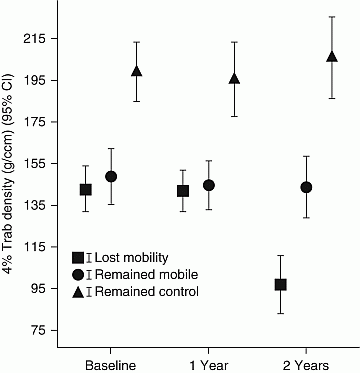ICCBH2013 Poster Presentations (1) (201 abstracts)
Cessation of ambulation results in a dramatic loss of trabecular bone density in boys with Duchenne muscular dystrophy
Nicola Crabtree 1 , Natalie Bebbington 1 , Helen Roper 2 , Heather McMurchie 2 & Nicholas Shaw 1
1Birmingham Children’s Hospital, Birmingham, UK; 2Birmingham Heartlands Hospital, Birmingham, UK.
Steroids are currently used to improve muscle strength and prolong ambulation in boys with Duchenne muscular dystrophy (DMD) although the effect on bone health is still unclear. The aim of this study was to compare bone strength in healthy children and boys with DMD and investigate the interaction between diminished muscle function, loss of ambulation and high dose oral steroids.
Fifty children were studied, 14 healthy boys (HB), 13 boys with DMD who remained ambulant (DMD-RA) and 23 boys with DMD who lost ambulation (DMD-LA). All boys with DMD were taking oral steroids. Peripheral quantitative computed tomography was used to measure bone geometry, density, strength, and muscle mass of the non-dominant tibia. Measurements were made at baseline, 12 and 24 months at the distal metaphysis and mid diaphysis sites. Differences between the three groups were evaluated using ANOVA and a repeated measures model.
There were no significant differences in age between the groups, mean age was 9.4 (2.7), 8.7 (1.9), and 8.8 (1.8) years for HB, DMD-RA and DMD-LA respectively. There was no significant difference in steroid exposure between DMD groups. However, boys who lost ambulation had significantly lower muscle function. Healthy boys had significantly greater trabecular bone density (26%) than boys with DMD (P<0.001). However, the rate of change of trabecular bone density was only significant for boys who lost ambulation. By 2 years non-ambulant boys had 51% less trabecular bone than their healthy age matched peers (see Fig. 1).

Previous work has suggested that loss of ambulation can be predicted by assessment of muscle function. Since this study highlights the dramatic loss of bone density with loss of ambulation, it is likely that functional assessment can help identify the point at which medical intervention to strengthen bones should be considered.




